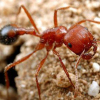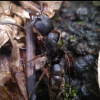- Formiculture.com
- Forums
- Gallery
- Members
- Member Map
- Chat

Are these springtails?
Started By
Broncos
, Nov 5 2019 8:56 PM
14 replies to this topic
#1
 Offline
-
Posted November 5 2019 - 8:56 PM
Offline
-
Posted November 5 2019 - 8:56 PM
I found these little guys a brownish yellowish color.
Currently Keeping:
Pogonomyrmex Californicus Bicolor & Concolor
Pogonomyrmex Subnitidius
Camponotus Sansabeanus
#2
 Offline
-
Posted November 5 2019 - 9:00 PM
Offline
-
Posted November 5 2019 - 9:00 PM
They are so tiny I can’t get a good pic but I will put a photo. They have been hiding under a pile of seeds and loose dirt.
Sent from my iPhone using Tapatalk
Sent from my iPhone using Tapatalk
Currently Keeping:
Pogonomyrmex Californicus Bicolor & Concolor
Pogonomyrmex Subnitidius
Camponotus Sansabeanus
#3
 Offline
-
Posted November 5 2019 - 9:07 PM
Offline
-
Posted November 5 2019 - 9:07 PM

Sent from my iPhone using Tapatalk
Currently Keeping:
Pogonomyrmex Californicus Bicolor & Concolor
Pogonomyrmex Subnitidius
Camponotus Sansabeanus
#4
 Offline
-
Posted November 5 2019 - 9:09 PM
Offline
-
Posted November 5 2019 - 9:09 PM
I give up on the photos they are tiny and yellow and brown. They are in large groups with very quick movement.
Sent from my iPhone using Tapatalk
Sent from my iPhone using Tapatalk
Currently Keeping:
Pogonomyrmex Californicus Bicolor & Concolor
Pogonomyrmex Subnitidius
Camponotus Sansabeanus
#5
 Offline
-
Posted November 7 2019 - 8:01 PM
Offline
-
Posted November 7 2019 - 8:01 PM
if dry they're likely psocids (bark/booklice)
i intentionally inoculate my desert species with these to keep odors and mold at bay, they are way better than springtails at cleaning, too.
They don't bite animals like springtails either, every time springtails invaded my enclosures they stressed the queens out and killed eggs
Edited by mbullock42086, November 7 2019 - 8:04 PM.
- Broncos likes this
#6
 Offline
-
Posted November 7 2019 - 8:12 PM
Offline
-
Posted November 7 2019 - 8:12 PM

Ok you can see two on the sunflower seeds.
Sent from my iPhone using Tapatalk
Currently Keeping:
Pogonomyrmex Californicus Bicolor & Concolor
Pogonomyrmex Subnitidius
Camponotus Sansabeanus
#7
 Offline
-
Posted November 7 2019 - 8:18 PM
Offline
-
Posted November 7 2019 - 8:18 PM
yeah psocids. springs can't tolerate dryness
#8
 Offline
-
Posted November 7 2019 - 8:20 PM
Offline
-
Posted November 7 2019 - 8:20 PM
Ok so they are safe to put into enclosures? Do they eat mold or developing mold or bacteria. Sorry I just have no idea what these things areyeah psocids. springs can't tolerate dryness
Sent from my iPhone using Tapatalk
Currently Keeping:
Pogonomyrmex Californicus Bicolor & Concolor
Pogonomyrmex Subnitidius
Camponotus Sansabeanus
#9
 Offline
-
Posted November 7 2019 - 9:34 PM
Offline
-
Posted November 7 2019 - 9:34 PM
They're safe, just populate quickly.
- Broncos likes this
#10
 Offline
-
Posted November 8 2019 - 7:23 AM
Offline
-
Posted November 8 2019 - 7:23 AM
Ok thanks!
Sent from my iPhone using Tapatalk
Sent from my iPhone using Tapatalk
Currently Keeping:
Pogonomyrmex Californicus Bicolor & Concolor
Pogonomyrmex Subnitidius
Camponotus Sansabeanus
#11
 Offline
-
Posted November 8 2019 - 11:10 AM
Offline
-
Posted November 8 2019 - 11:10 AM
Those could also be dustlice (booklice). If they're moving quickly it's more likely that they're springtails though.
Edited by Serafine, November 9 2019 - 8:53 PM.
We should respect all forms of consciousness. The body is just a vessel, a mere hull.
Welcome to Lazy Tube - My Camponotus Journal
#12
 Offline
-
Posted November 8 2019 - 7:42 PM
Offline
-
Posted November 8 2019 - 7:42 PM
They're Booklice. In your formicarium, they serve the same purpose as springtails, except they live in very dry areas of the nest.
- Broncos likes this
#13
 Offline
-
Posted November 8 2019 - 9:44 PM
Offline
-
Posted November 8 2019 - 9:44 PM
if dry they're likely psocids (bark/booklice)
i intentionally inoculate my desert species with these to keep odors and mold at bay, they are way better than springtails at cleaning, too.
They don't bite animals like springtails either, every time springtails invaded my enclosures they stressed the queens out and killed eggs
springtails can bite and killed eggs???
i thought they are harmless
Colony:
2 Odontomachus aciculatus
2 Polyrachis Dives
3 Camponotus sp
#14
 Offline
-
Posted November 9 2019 - 7:40 PM
Offline
-
Posted November 9 2019 - 7:40 PM
if dry they're likely psocids (bark/booklice)
i intentionally inoculate my desert species with these to keep odors and mold at bay, they are way better than springtails at cleaning, too.
They don't bite animals like springtails either, every time springtails invaded my enclosures they stressed the queens out and killed eggsspringtails can bite and killed eggs???
i thought they are harmless
they are, not sure how they "bit" eggs. Jaws only really suited for eating decaying matter. Perhaps the eggs molded slightly after the queens got stressed and were eaten.
#15
 Offline
-
Posted December 5 2019 - 12:53 PM
Offline
-
Posted December 5 2019 - 12:53 PM
if dry they're likely psocids (bark/booklice)
i intentionally inoculate my desert species with these to keep odors and mold at bay, they are way better than springtails at cleaning, too.
They don't bite animals like springtails either, every time springtails invaded my enclosures they stressed the queens out and killed eggsspringtails can bite and killed eggs???
i thought they are harmless
they are, not sure how they "bit" eggs. Jaws only really suited for eating decaying matter. Perhaps the eggs molded slightly after the queens got stressed and were eaten.
Springtails didn't attack the eggs directly but they interfered by freaking the queen out making her neglect her eggs and not groom them. HOWEVER that said, they ARE known for attacking amphibia and molting animals.
Fortunately they're so small its generally superficial though
0 user(s) are reading this topic
0 members, 0 guests, 0 anonymous users

















